3 History, development trends and the future
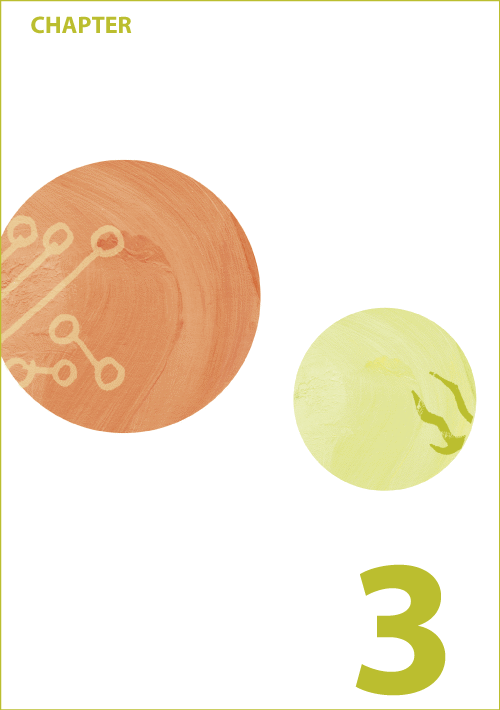
Figure 3.1
“Those who do not know the past do not understand the present, and are not well-suited to design the future.”
Source Simone Weil
Planning for the future must be based on experience and grounded in history. By the same token, it is important to be open to new possibilities and let go of traditional ways of thinking. When addressing future challenges in the care services, it will be necessary to employ new methods and find new solutions rather than simply prolonging current trends and developments. It would be too naive a solution for the care services merely to increase the number of nursing home beds to keep pace with the rise in the number of elderly over 80 years of age. If there is as much change in the municipal health and care services in the next 40 years as has been the case in the past 40, the situation will look entirely different.
3.1 Forty years in the past and 40 years in the future
The public care services as we know them today have a brief history. In 40 years these services have expanded from some 20 000 person-years to more than 120 000 person-years. They have gone from focusing primarily on care for the elderly to providing services to users in all age groups with diverse diagnoses, disabilities and conditions. Some people receive services from birth and are dependent on the care services throughout their entire lives, while others receive just a few services for a limited period of time.
When planning for the future, there is good reason to place our efforts in the context of this relatively brief history. We should explore why the municipal care services were established, how conditions have changed through the years and what driving forces underlie developments characterised by strong, constant growth.
Official Norwegian Report 2011: 11 Innovation in the Care Services describes the development of care services in the past 40 years as one of the greatest social innovations of the post-war period. Public care services emerged in response to some of the most crucial challenges facing society:
“Thus, the question was what was needed to ensure a higher birth rate, access to labour, women’s liberation and care for the rising number of elderly, all at the same time. In light of this, the 40-year history of the municipal care services can be described as one of the truly significant innovations of Norwegian society in the post-war period. A large public welfare sector in the Nordic countries has helped to lay the foundation for economic growth and development and to create the security needed to bring children into the world. Against this backdrop, the Nordic model demonstrates greater economic and demographic sustainability than many other wealthy countries that do not have such as extensive care services sector.”
Like other welfare schemes, the care services must be assessed in light of their significance for value creation in society and not merely be viewed as an ever-increasing public expenditure. Norway has consciously chosen to organise society in this way. This has proved to be successful both in economic and in demographic terms.
3.2 Recipients of care services – status and development trends
In the period from 1965 to 1980, the number of people receiving in-home nursing services more than tripled, from 24 000 to 75 000 recipients. Recipients of housekeeping services increased even more, from about 13 000 people in 1965 to roughly 98 000 recipients 15 years later. The number of people receiving in-home nursing services and housekeeping services continued to rise in the 1980s, although at a slower pace than during the previous decade. In the 2000s, home care services have become more focused on those in greatest need of assistance. The proportion of users receiving only practical assistance has declined from almost half to one-fourth of all recipients. The number of residents in institutions increased up until about 1990, when responsibility for nursing homes was transferred from the counties to the municipalities and the institutions under the system of health care for individuals with cognitive impairments were closed down. Since then, the number of residents of various institutions has decreased, while the number of recipients of home care services and residential care homes has risen dramatically.
3.2.1 From care for the elderly to care for all
Despite substantial growth in the oldest age groups in recent decades, the number of elderly users of old-age and nursing homes and home care services has not risen. This demonstrates that not everything can be explained by demographics, and that developments are also affected by other changes in society. For instance, part of the explanation for this situation may lie in the redistribution of tasks between the specialist health care services, informal care provided by families and the municipal care services. Over time it has become less appropriate to use the term “elderly care” to describe the municipal care services.
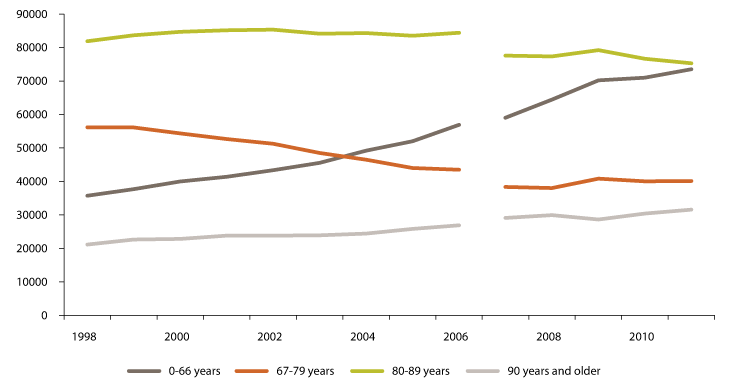
Figure 3.2 Number of recipients of care services by age 1998–2011
Source Statistics Norway 2012. As from 2007 the data is taken from the IPLOS register and cannot be compared with previous years.
Today the care services sector has recipients of all ages with highly divergent needs. At the end of 2011, more than 268 000 people had received care services in one form or another. Of these, about 43 500 people received services in an institution and some 177 000 were recipients of in-home nursing care and/or practical assistance. Roughly 50 000 people received other types of services such as relief from the caregiving burden, pay for family caregivers, individual support persons and user-driven personal assistance. These types of services are provided mainly to people under age 67. In 2011, more than 122 000 people over 80 years old received services in institutions or at home. Approximately two of three recipients of care services are women. This is partly because women live longer than men and have a longer period of serious illness and reduced functionality towards the end of their lives. Seventy-five per cent of recipients of in-home care services over the age of 90 live alone.
Almost 72 000 new recipients entered the care services system in 2009, 2010 and 2011, respectively, while some 69 000 recipients left the system in each of those years. This shows that roughly one-fourth of care services recipients are rotated out of the system each year. This in turns means that care services are provided to roughly 25 per cent more recipients than the average figures shown above indicate.
Information about recipients’ need for assistance is available from the IPLOS registry, the individual-based nursing and care statistics compiled by the Norwegian Directorate of Health. The need for assistance is a measure of the degree to which recipients are capable of helping themselves in most areas (need for some/limited assistance) or dependent on help in many areas (need for extensive assistance). Approximately 33 per cent of recipients over 90 years old have a need for extensive assistance. A total of 17 to 25 per cent of recipients in other age groups have a need for extensive assistance. The trend is towards a decline in the proportion of recipients with a need for limited assistance. Long-term residents of institutions generally have a need for more extensive assistance than recipients of home care services. Four of five long-term residents of institutions have a need for extensive assistance. The need for assistance is greater among younger rather than among elderly recipients of in-home nursing care and practical assistance. The reason is that many elderly people with a need for extensive assistance receive help in the form of a long-term space in an institution. Younger users with a need for extensive assistance receive more hours of in-home nursing care and practical assistance than elderly users with a comparable need for services.
3.2.2 The number of younger recipients of care services is increasing
Almost four of 10 recipients of nursing and care services are now under retirement age. In addition, practically all of the new resources allocated to the sector in the past 20 years have gone to covering the service needs of the rising number of younger user groups. Users of home care services under age 67 are distributed to some children and adolescents under age 18 (two per cent), a large proportion of younger adults age 18–49 (54 per cent) and a somewhat smaller proportion of middle-aged people age 50–66 (44 per cent). Of these groups, the most dramatic growth in the past decade has been in the number of younger adults. If recipients of relief from the caregiving burden, individual support persons and pay for family caregivers are included in the statistics, the number of children and adolescents is higher.
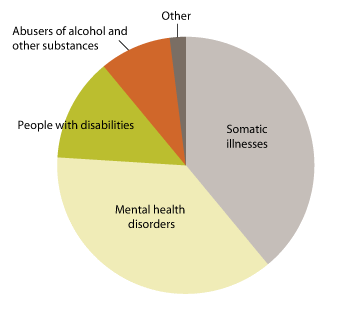
Figure 3.3 Causes of the need for assistance among recipients of home care services under 67 years old
Source Romøren (2006)
In terms of health, the group of recipients receiving home care services under age 67 is comprised of two larger and two smaller groups. The largest group are people with a wide variety of somatic illnesses (39 per cent), comprised primarily of neurological conditions such as MS, stroke, and head and back injuries. Mental health disorders comprise a large group as well (37 per cent). The two smaller groups are people with disabilities (13 per cent) and abusers of alcohol and other substances (9 per cent). Those in the user group under 67 years old primarily receive home care services and very few live in institutions. Many of these recipients receive as many home care services and participate in as many daytime activity programmes as those living in nursing homes, measured in number of hours. Many of them attend school or work during the day. It is difficult to predict the extent to which the number of younger recipients of care services will continue to increase in the coming years. There is reason to believe that the growth will slow or stabilise, although there is no indication of when. It is crucial to acquire more research-based knowledge about this for planning purposes.
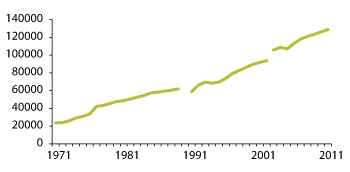
Figure 3.4 Person-years in the care services sector 1971–2011
Please note: Due to the gap in statistics, the figures from 2003 and onward cannot be compared to figures from 2002 and earlier. Statistics are not available for 1990. The figures also include the system of health care for individuals with cognitive impairments (HVPU) up until it was discontinued in 1991.
Source Statistics Norway
3.3 The care services – status and development trends
The greatest changes in the municipal health services in recent decade have occurred mainly in the home care services, where the in-home nursing services in particular have risen. This is a reflection of two major development trends, which show that there is a shift:
from services provided in institutions to services provided in people’s homes
from practical assistance to health care services
3.3.1 From 20 000 to 130 000 person-years
Except for one year, the municipal care services have seen continual growth in the past 40 years. Measured in terms of the number of person-years, the care services sector has grown six-fold and increased from about 20 000 person-years in 1971 to almost 130 000 person-years in 2011.
The rate of growth has increased in the past 25 years after municipal responsibilities expanded with the nursing home reform and the reform relating to people with disabilities. The Action Plan for Elderly Care, the Care Plan 2015 and the Government’s Escalation Plan for Mental Health have also led to an increase of resources and tasks, and the Coordination Reform is expected to reinforce this situation even further in the years to come. The dramatic growth must be viewed in connection with changes in the distribution of tasks with the specialist health care services and informal care. Both of these factors have contributed to the increase in the number of person-years. It is the in-home nursing services in particular that have increased, and these services are being directed more and more towards those with the greatest need.
Despite the significant rise in the proportion of elderly among the population, the largest growth has occurred in the services provided to people under 67 years old. The municipal care services are intended primarily for people with long-term, complex conditions and substantially reduced functionality. This requires a high level of expertise and greater interdisciplinary cooperation. At the same time, there is reason to question whether it has become more difficult to qualify for help, so that the care services are pulled in too late, and to the detriment of early intervention, prevention and rehabilitation. This may prove to be an expensive and unsustainable solution in the long term.
It will be important for the municipalities to find the right balance between treatment and nursing on the one hand and prevention, habilitation and rehabilitation on the other.
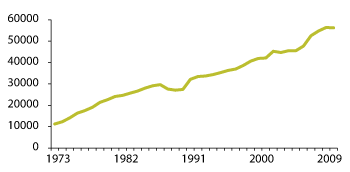
Figure 3.5 Gross operating expenses in fixed 2000 prices for nursing and care 1973–2010
Please note: The figures also include the system of care services for individuals with cognitive impairments people (HVPU) until it was discontinued in 1991.
Source Statistics Norway
With a few minor exceptions, gross operating expenses for the care services have shown a relatively linear increase, measured in fixed NOK since the 1970s. Over a 40-year period, operating expenses have risen five-fold with average annual real growth of 4.5 per cent, except for the period around 1990 and 2002–2005.
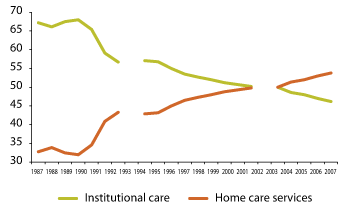
Figure 3.6 Proportion of person-years in the nursing and care services sector in percent, by institutional care and home care services 1987–2007
Source Brevik 2010, Norwegian Institute for Urban and Regional Research
3.3.2 From institution to home care services
Today the municipalities allocate more resources to home care services than to nursing homes and institutional care services. In contrast, 40 years ago over 80 per cent of operating expenses went to old-age and nursing homes, while only 20 per cent went to the operation of home care services, primarily professional homemaker and housekeeping services.
While 25 years ago as many as two-thirds of the person-years in the care services were associated with institutional care and only one-third with home care services, the ratio has now changed so that the proportion of person-years is largest in the home care services.
This development is due to reform efforts, professional and financial assessments in the municipalities, and greater involvement by the users in designing the services. The nursing home reform gave responsibility for home care services and nursing homes to the municipalities, which had to decide how they would organise the services to ensure the greatest overall impact. As a consequence, most of the growth in the care services occurred in home care services in the years following the reform. As long as the counties were responsible for nursing homes, the municipalities did not incur any costs.
Deinstitutionalisation was seen most clearly in the reform of services for individuals with cognitive impairments, where the system of care services in place (HVPU) and the HVPU institutions were closed down in the period from 1991 to 1995, and responsibility for these services transferred to the same agencies as for population at large. Integration, normalisation and participation comprised the key principles behind the measures to move people who previously lived in institutions into their own homes and provide them with health and care services adapted to their needs. At the same time, the services for those who had not previously been given a space in an institution were strengthened considerably. These users were given the right to the same services as the former residents of institutions. Other user groups were granted similar rights in the wake of the reform. This trend was further enhanced by Unge ut av institusjon, a project to move youth out of the institutions, and by the Escalation Plan for Mental Health. Some of this same development was incorporated into the Government’s Dementia Plan 2015 and Nevroplan 2015 (“Neuro Plan 2015”) for people with neurological injuries and disorders.
The municipalities are responsible for providing necessary, safe services that meet the needs of individuals. Each municipality decides itself how these services will be organised based on local conditions and needs. As figure 3.7 shows, the way in which the municipalities have organised their health and care services varies widely. Twenty per cent of the municipalities use less than 40 per cent of the care services’ net operating expenses for institutions and more than 60 per cent on home care services. In 10 of these municipalities the share of expenses used for institutions is less than 20 per cent. In contrast, 15 per cent of the municipalities use more than 60 per cent of their expenses on institutions, and 11 of these use 80 per cent or more on institutions. However, almost two-thirds of the municipalities use 40–60 per cent on institutions, and the national average in 2011 was 46 per cent.
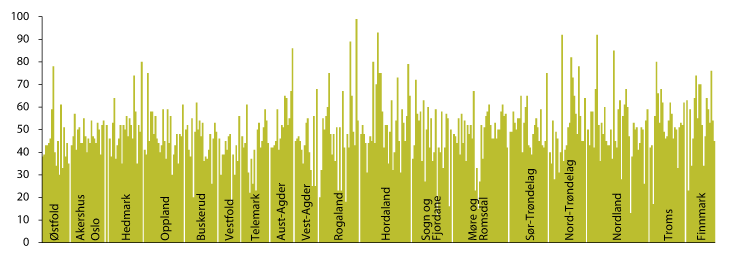
Figure 3.7 Proportion of the care services’ net operating expenses used for institutional operations in 2011, per municipality by county. Per cent.
Source Statistics Norway 2012
Some municipalities have still chosen to focus on nursing homes and institutional operations, while other municipalities emphasise home care services, daytime activity programmes and residential care homes. This is reflected partly in the variation in the cost of a space in a nursing home from NOK 500 000 to over NOK 2 million annually at the municipal level. However, it is the overall set of services that is most crucial for the residents of the individual municipality. All the same, studies indicate that municipalities which focus on home care services get more out of their resources than municipalities that put more emphasis on institutional services. One relevant report states:
Therefore, an orientation towards home care services appears to be more effective in the sense that more people receive services that use fewer resources without a documented decline in the quality of the services.
3.3.3 From old-age homes to nursing homes and residential care homes
The days of the old-age home are past. Thus an era with its origins in the poorhouses of the past is over. Forty years ago there were more spaces in old-age homes than in nursing homes. While the old-age homes have been phased out since the municipalities assumed responsibility for nursing homes, the number of nursing home beds has increased from about 15 000 to 40 000 in the past 40 years.

Figure 3.8 Number of spaces in institutions and residents of housing for care purposes 1970–2011
Please note: As from 2007 the data is taken from the IPLOS register and cannot be compared with previous years. Nor can figures for residents of housing for nursing and care purposes prior to 2009 be compared directly with figures after 2009.
Source Statistics Norway
Some old-age homes have been modernised and remodelled into nursing homes, but many old-age homes were so unsuitable or in such poor condition that they were replaced with new structures. In accordance with Report No. 50 (1996–1997) to the Storting, Handlingsplan for eldreomsorgen (“Action Plan for Elderly Care”), old-age homes were largely replaced with new, modern residential care homes. A large number of these have also been built in the municipalities for younger people with a need for adapted housing and services. More than one-third of people living in residential care homes are under the age of 67. Of these, half have a cognitive disability and the other half either have mental health and social problems or long-term reduced functionality resulting from somatic illnesses, often neurological in nature. Over half of those living in homes for people in need of 24-hour services are under 67 years old.
The Action Plan for Elderly Care implemented the single-room reform, and half of Norway’s nursing home spaces were either newly constructed or fully modernised. Nursing homes have therefore been expanded, renewed and renovated, both in terms of the buildings and to some extent with regard to the expertise needed to perform the tasks that the sector is now dealing with.
However, when addressing future challenges, there is a need for adaptation and restructuring in connection with the new, expanded tasks. As a result of the Coordination Reform, the pressure on 24-hour care spaces will continue to intensify, especially with regard to short-term spaces for relief from the caregiving burden, rehabilitation, training and emergency assistance. There will also be a need to modernise and renew old buildings that were not renovated under the Action Plan for Elderly Care. This should be done before the pace of expansion must be ramped up once again in 10 years due to the rise in the number of elderly over 80 years old.
The Dementia Plan 2015 also states that nursing homes with large wards and long corridors do not work well for people with dementia and other forms of cognitive decline. Since 80 per cent of nursing home patients today suffer from dementia, the Norwegian State Housing Bank’s support scheme has stipulated that all nursing homes and residential care homes must be built as small, adapted units, whether they are organised as small wards or as shared flats with several residents.
There is therefore much evidence to suggest that the more traditional institutions are on the way out and that new solutions will be created in the future that take the best from both the institution and the home care traditions. The question is what the new senior generation will want and prefer. Will they follow in the footsteps of the younger user groups or will they want to retain the institutions in their present form?
The kind of living arrangements that the municipalities offer to people with a need for 24-hour services varies widely. Figure 3.9 shows that the four northernmost counties have the highest overall coverage of 24-hour services (24-hour care spaces as a percentage of the elderly 80 years and older). However, while Finnmark county has the highest nursing home coverage, Nord-Trøndelag county has the highest coverage with regard to 24-hour spaces in residential care homes. The percentage of residential care homes coverage in Østfold, Buskerud and Telemark counties is high as well, while nursing home coverage is highest in Oslo and Sør-Trøndelag county, which so far have very few residential care homes. The level of coverage for the entire country is 28 24-hour care spaces as a percentage of the population 80 years and older, of which 18.5 spaces are in nursing homes.
3.3.4 From professional housekeeping and homemaker services to in-home nursing services
Three of four new positions in the care services in the past 15–20 years have been created within the home care services, with in-home nursing services representing much of the increase. Forty years ago, in-home nursing services comprised only 10 per cent of all the home care services, which at that time consisted mainly of professional homemaker and housekeeper services. Whereas professional homemaker services have disappeared and practical assistance has remained at roughly the same level in recent years, in-home nursing services have seen considerable growth and come to play a more prominent role in the municipal health and care services as a whole. This development reflects the fact that home care services have become more medically oriented and give priority to health over social services. At the same time, the process of phasing out old-age homes and expanding nursing homes has meant that medical treatment and nursing have been given a far more critical role in institutional care as well.
In addition, college-educated professional groups such as social educators, social workers, child care workers and special education professionals have also become a part of the home care services, and the percentage of person-years from these groups has risen within the health and care services.
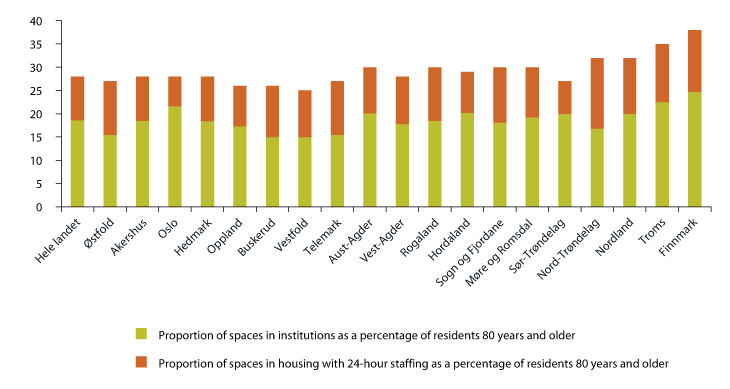
Figure 3.9 Spaces in institutions and housing with 24-hour staffing 2011 as a percentage of residents 80 years and older
Source Statistics Norway 2012
According to the Norwegian Directorate of Health:
The changes in the nursing and care sector in recent years have been so far-reaching that the municipalities have had their hands full just handling the new younger groups of recipients and the elderly most in need of care. As a result, there have been too few resources to give adequate priority to practical, social and preventive services among the younger group of elderly as well.
Despite strong growth in staffing and greater professional expertise in both nursing homes and home care services, there is much evidence to suggest that the direction taken by the services has been to the detriment of early intervention, prevention and rehabilitation. The Government wishes to help to improve the balance between treatment and prevention and between nursing and habilitation/rehabilitation.
The care services of the future must put more emphasis on active care and training through physical, social and cultural activities in order to meet the needs of new younger user groups who require personal assistance and the new generations of elderly. This will require a broader range of professional expertise with a different constellation of knowledge and skills as well as other professional approaches and work methods than is the case today.
3.4 Care Plan 2015
Several long-term, action-oriented strategies and measures underlie the development of the care services. The Care Plan 2015 is the Government’s plan to enhance the capacity, expertise and quality of the municipal care services. The plan was presented in autumn 2006, and the measures and instruments have been implemented during the current and previous governments.
24-hour care spaces
The investment grant provides pledges for allocations for the construction or improvement/renovation of 12 000 24-hour care spaces in the period from 2008 to 2015.
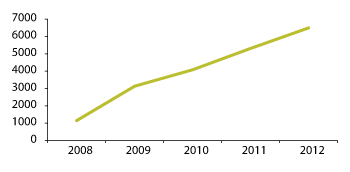
Figure 3.10 Number of pledges for allocations for 24-hour care spaces in nursing homes and residential care homes 2008–2012
Source Norwegian State Housing Bank 2013
The municipalities are eligible for pledges from the Government for funding for a total of 9 500 units from 2008 through 2012. In the same period, the municipalities have submitted applications for about 6 500 units, and the Norwegian State Housing Bank has issued pledges for allocations for roughly 6 300 units. About half of these pledges have been issued for spaces in nursing homes (54 per cent) and the other half for spaces in residential care homes (46 per cent). Almost 60 per cent of the total number of units for which pledges have been issued involve the construction of new buildings. In the national budget for 2013 (Prop. 1 S (2012–2013)), the Government has approved pledges for allocations for 1 750 units in 2013. Developments indicate that the target of 12 000 spaces will likely be achieved by the end of 2015.
Increase in the number of person-years
In its first platform the Government established a target that increased the staffing in the municipal care services by 10 000 person-years by the end of 2009, based on 2004 levels. This target was exceeded with an increase of person-years of about 14 800. In its second platform the Government set a target to increase staffing in the municipal care services by 12 000 person-years in the period 2008–2015, measured at the end of the year.
The total increase in person-years to date in the current government term (2005–2011) has been about 22 000 person-years. Some 80 per cent of this growth has consisted of personnel with education in health and social care subjects. The proportion of personnel with an education in health and social care within the health and care services sector has thus risen from 66.4 per cent in 2005 to 69.1 per cent in 2011, helping to enhance both capacity and expertise within the services.
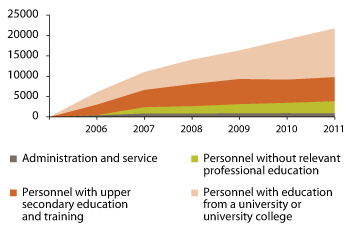
Figure 3.11 Increase in person-years within the nursing and care services sector 2005–2011
Source Statistics Norway 2012. The increase in person-years is measured from the end of 2005 to the end of 2011.
The proportion of personnel with a university or university college education has increased from 27.4 per cent to 32 per cent in the period from 2005 to 2011. The figures show that the increase in person-years has primarily involved nurses, which rose from 18.1 per cent in 2005 to 19.7 per cent in 2011 of the total number of person-years in the sector. There was a concurrent rise in the overall proportion of social educators, social workers, occupational therapists and child care workers from 5.9 per cent to 6.7 per cent. Here, social educators comprised the largest group by far. In 2011, the number of social educators corresponds to about 30 per cent of the number of nurses without an education in a specialisation.
The proportion of personnel with upper secondary education and training has shown a slight decline in the years since 2009. Most of this decline is due to a small decrease in health care workers, nursing assistants and care services workers, which this group primarily comprises. Taken together, these groups currently represent 35.3 per cent of the total number of person-years. The proportion of personnel without relevant professional education has declined in this period from 28.6 per cent in 2005 to 26.1 per cent in 2011, while the proportion of person-years that perform administrative and service tasks has remained stable.
Kompetanseløftet 2015 (“Competency Reform 2015”)
Kompetanseløftet 2015 (“Competency Reform 2015”) is the Government’s competency and recruitment plan, and has as its primary objective to ensure that the municipal care services sector is adequate, competent and has stable staffing. A total of over NOK 300 million is used annually on competency and recruitment measures under the Competency Reform 2015.
The Competency Reform has five secondary objectives for the period 2011–2015: to increase staffing in the municipal health and care services by 12 000 person-years; to raise the level of education among care services personnel; to ensure an overall supply of about 4 500 health care workers per year; to broaden the sector’s professional scope; and to enhance guidance, internal training and further education.
In the first six years of the plan period (2007–2012) roughly 21 000 people have completed basic, further or continuing education or another type of training with support from the Competency Reform 2015.
Development centres for nursing homes and home care services have been established in all counties throughout Norway. The centres are to serve as catalysts for knowledge and quality in the care services by conducting research, professional development and competency building activities, in addition to promoting the further development of practicum opportunities for pupils, apprentices and students. The municipalities with development centres are part of a common network and are linked to the regional centres for care research.
Dementia Plan 2015
The Dementia Plan 2015 was presented in autumn 2007. The objective of the plan is to strengthen services to people with dementia through three main measures: enhancing knowledge about and expertise on dementia, increasing daytime activity programmes, and creating more adapted housing.
A national overview of services for people with dementia has been compiled which shows that the municipalities have increased their activities for people with dementia and their close family members in the period 2007–2010 under the Dementia Plan 2015. The number of municipalities with training for family members has almost quadrupled during this period and comprised 246 municipalities at the last review. At the end of 2012, more than 14 000 employees in about 85 per cent of the country’s municipalities had begun internal training programmes on how to care for people with dementia.
In 2011, the Dementia Plan was revised with a new four-year action programme (2012–2015). One of the main objectives of the revised plan is to legally require the municipalities to offer daytime activity programmes for people with dementia when they expand their services. Therefore, in 2012 an earmarked funding was allocated to encourage the municipalities to establish spaces in daytime activity programmes for people with dementia. To date, funding has been allocated for the establishment of almost 1 000 spaces.
Care services research
To strengthen the knowledge base in the care services sector, the Government has ensured an escalation of funding for care services research. In 2013, the allocation for care services research is NOK 37 million. This will help to expand the knowledge base for use in the planning, development and organisation of the care services. The funding is being channelled through the Research Council of Norway.
To strengthen practice-based research and development in the municipal care services sector, five regional care services research centres have been established. The centres are affiliated with educational institutions that provide training for health and social care personnel.
The Cultural Walking Stick programme
The Government has established the Cultural Walking Stick programme to enhance cultural activities for users of the care services. The programme was established in 2007. Approximately NOK 30 million has been allocated to cultural activities under the programme in 2013.
Neuro Plan 2015
Neuro Plan 2015 has been drawn up to highlight and draw attention to care services recipients with neurological disorders. The plan was presented in autumn 2012 and is intended to enhance expertise and quality in the municipal services with regard to people with neurological disorders. The plan has three main focus areas: information and new knowledge, rehabilitation in daily life through activities and training, and multidisciplinary development activity.
The agreement on quality and project on ethics
In December 2012, the Government and the Norwegian Association of Local and Regional Authorities (KS) entered into an agreement on quality development in the municipal health and care services. The agreement is based on the consultation scheme between the Government and KS. The agreement on quality sets out objectives and strategies for developing the quality of the municipal health and care services.
Under the project on cooperation on building competency in ethics, more than 200 municipalities have established various meeting places to strengthen expertise in ethics within the municipal health and care services. A handbook of methods and e-learning tools on ethical reflection have been developed as well. The project was launched in 2007 and will last until the expiry of the Care Plan 2015.
The Ministry of Health and Care Services has established eight principles for good care services in cooperation with the Norwegian Association of Local and Regional Authorities (KS), the Norwegian Nurses Organisation, the Norwegian Union of Municipal and General Employees, the Norwegian Union of Social Educators and Social Workers, the Church City Mission and the Norwegian Pensioners Association. The principles are intended to serve as a point of departure for reflection, culture building and local improvements within the services. As a follow up to these efforts, the Norwegian Directorate of Health is in the process of developing new quality indicators for the care services.
Regulations on dignified elderly care
To ensure that the elderly are not neglected with regard to the overall activities of the nursing and care services, the Government has drawn up regulations that specify the municipalities’ obligations related to care for the elderly (“guarantee of dignity”).
The regulations describe the values underlying elderly care and set out the measures to be implemented within the care services, such as appropriate and safe forms of housing, a varied and adequate diet, palliative treatment and a dignified death, professionally sound follow-up by doctors and other relevant personnel, conversations about existential questions, etc. The complaints and inspectorate authorities are responsible for ensuring that municipalities adhere to the “guarantee of dignity”.
3.5 Projections
3.5.1 Changes in demographics
We are facing an unprecedented global demographic challenge caused by an ageing population that will continue to grow, and the far-reaching consequences of an economic, social, political and cultural nature that will follow as a result. This is the conclusion reached in the United Nations report World Population Ageing 1950–2050 from 2001.
In terms of demographics, Norway is one of the European countries that will experience the least dramatic changes in the age composition of the population. This is partly because Norway has already undergone such changes and partly because Norway has a higher birth rate.
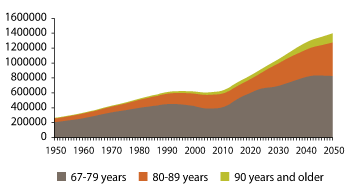
Figure 3.12 Number of persons in the age group 67 years and older 1950–2050
Source Statistics Norway 2012. Median alternative (MMMM) for the population projections.
The population of Norway has more than doubled in the past century, from 2.2 million in 1900 and 3.3 million in 1950 to 4.5 million in 2000. According to population projections from Statistics Norway, the population will continue to climb at an even pace to 6 million in 2030 and 6.7 million in 2050.
The number of people over age 67 will more than double in the period from 2000 to 2050. The number of people over 80 years old will increase from 190 000 in 2000 to almost 350 000 in 2030 and nearly 570 000 in 2050. The growth in the age group 80–89 years will begin in 10 years from now. There will be dramatic growth in the group of elderly 90 years and older in the next few years.
It was decided to use the median alternative in the population projections as the basis for the statistical analyses related to median fertility rate, median life expectancy, median net immigration and median mobility (MMMM).
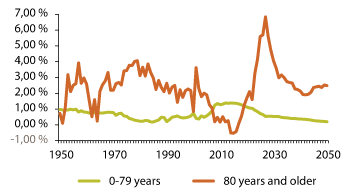
Figure 3.13 Annual percentage change in the number of persons over and under 80 years old 1950–2050
Source Statistics Norway 2012. The median alternative (MMMM) for the population projections.
The upcoming demographic changes are often depicted as an uncontrolled elderly boom that will sweep the entire country. However, in the next few decades the number of elderly over age 80 will not increase; in fact it will decrease slightly. This presents an opportunity to plan and prepare for the changes that will occur in the age composition of the population further in the future.
The number of elderly, especially those over 80 years old, has been increasing substantially ever since 1950. The next 15 years there will be smaller growth and even a decline. Then the number of elderly over 80 years of age will rise dramatically in the period from 2020 to 2035 with up to seven per cent growth from one year to the next.
In the next few years, the growth will occur among the youngest elderly in the 67–79 age range, which will present a special challenge for the home care services. The number of people over 80 years old will remain stable in the next 10–15 years, except for the age group over 90 years. Due to the increase in the number of the most elderly, 24-hour services will need to be further expanded. It will also be crucial to take advantage of the relatively stable demographics in the next 10–15 years by gradually expanding the services and preparing for the rapid rise in the number of elderly over 80 years of age.
Special focus on dementia
Most elderly people are healthy, but most sick people are elderly. The incidence of illness and injuries rises with increasing age, and a significant proportion of elderly contract diseases or sustain injuries that result in varying degrees of reduced functionality. This applies in particular to people who develop dementia. Today there are about 70 000 people with dementia in Norway, and it is estimated that some 250 000 people – both patients and their close family members – are affected by the disease. About 10 000 people per year are diagnosed with dementia. Since the number of elderly over 75 years old, especially those over 80 years, will increase in the coming decades, the number of people with dementia in Norway could double to about 140 000 over the next 25–30 years.
The large number of people affected by various types of dementia presents major challenges for the public administration, health care personnel and the service structure in terms of both planning and adapting services that are professionally sound and customised for individuals.
Recipients of services with an immigrant background
The number of elderly people with an immigrant background in Norway will rise in the near future. For the first time, Statistics Norway has prepared an estimate of the number of immigrants or those who were born in Norway to two immigrant parents living in all counties throughout the country as well as in some of the larger municipalities up until 2040. These groups will grow substantially in the future, especially in the major metropolitan areas. The care services must be adapted in a way that ensures these users receive sufficient services of high quality. The changing composition of the users’ cultural and religious backgrounds will be a crucial factor in the design of the services and will pose new requirements for individual adaptation.
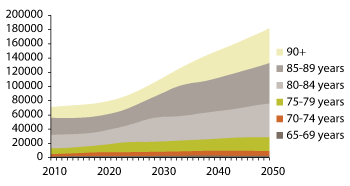
Figure 3.14 Number of persons with dementia projected for 2010–2050
Source Ministry of Health and Care Services. Estimated on the basis of a given percentage of incidence of dementia per age group. Based on the median alternative (MMMM) for the population projections.
Age composition and the Potential Support Ratio
The Potential Support Ratio shows the relationship between the working population (16–66 years) and the elderly population (67 years and older), and is of great relevance with regard to potential economic support, welfare benefits, and health and social services in the future. In 2000, there were 4.7 people of working age per elderly person, whereas the Potential Support Ratio will drop to 3.5 in 2030 and to 2.9 in 2050. The decline in the proportion of people of working age in relation to the elderly will likely present a challenge to the personnel situation within the health and care services sector as well as to value creation and the development of welfare.
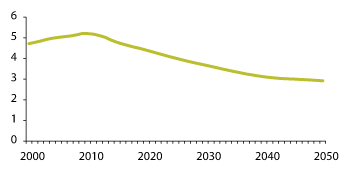
Figure 3.15 Number of persons of working age (16–66 years) per number of elderly 67 years and older (Potential Support Ratio) 2000–2050
Source Statistics Norway 2012. The median alternative (MMMM) for the population projections.
Care providers within the family network
Changes in the age composition of the population have an impact on the number of informal care providers on whom the elderly can rely, and will affect informal care patterns in the future.
The UN’s Parent Support Ratio, or the ratio of the number of people over age 85 to the number of people age 50–66, is a demographic expression of the potential ability to provide care to the elderly.
The Parent Support Ratio is highly relevant for Norway, but it can paint a rather simplified picture of future developments because trends other than age composition are significant for the potential of families to provide care and because cultural changes affect caregiving as well. In Norway, the volume of informal care has been stable in the past 20–30 years in areas for which statistics have been compiled. It appears that families and public care providers complement each other under certain conditions. Families are able to participate in caregiving if they do not have to assume the entire responsibility.
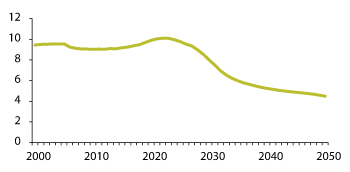
Figure 3.16 Number of persons in the 50–66 age group per person in the age group 85 years and older (Parent Support Ratio) 2000–2050
Source Statistics Norway 2012. The median alternative (MMMM) for the population projections.
3.5.2 Personnel needs
The projections on personnel needs up to 2050 have been developed by Statistics Norway. They are based on assumptions regarding some of the most critical driving forces underlying the demand for care services: demographics, morbidity, the volume of informal care, and the standard of the services.
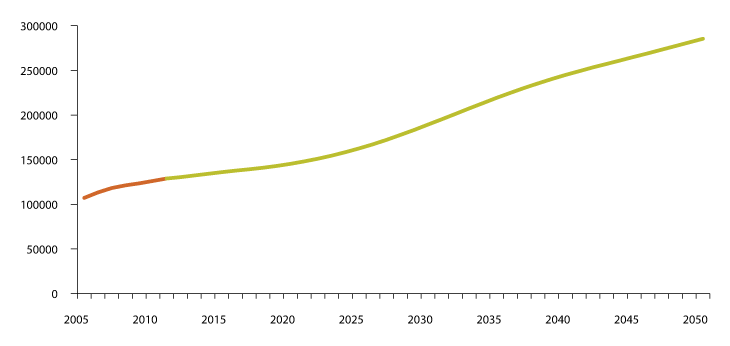
Figure 3.17 Projection on personnel needs in the care services sector 2012–2050 in number of person-years
Source Statistics Norway
Numerical projections of this type will always be surrounded by considerable uncertainty. There is little research on trends in the need for care services on which to base projections. In addition, it is important to emphasise that the projections do not take into account the impact of the strategies and measures designed by the Government to prevent or reduce the increase in the need for care services in the future. Thus, the projections are not intended as a prediction of the future, but as an illustration that can inform the debate on the kind of future Norway seeks to have.
Personnel needs up to 2050
The projection in figure 3.17 shows the personnel needs in the municipal care services sector up to 2050 under the following conditions: the size and composition of the population follow the median alternative in the latest projections from 2012 by Statistics Norway; the volume of age and gender-specific person-hours per user is continued at the 2010 level (constant standards); age-specific morbidity is reduced in keeping with increasing life expectancy so that the period when people are intensive users of care services towards the end of their lives remains roughly unchanged in the coming decades (postponed morbidity); the volume of informal care remains constant at about 100 000 person-years (unchanged informal care).
The projection shows that the number of person-years in the care services sector may increase by almost 50 per cent or about 60 000 person-years up to 2030 and be more than doubled up to 2050.
Figure 3.18 shows that the annual increase in person-years will be greatest from around 2025, peak just after 2030 with about 6 000 new person-years annually and then stabilise at a higher level just after 2040 with an increase in person-years of about 4 000 new person-years annually.
In addition, projections regarding the labour market for health and social care personnel show a cumulative shortage of the largest groups of educated workers in the care services sector amounting to about 55 000 person-years in 2030.
Due to a shortage of personnel with an education in health and social care combined with a growing need for recruitment, it will be necessary to recruit from a broader base and seek out personnel with a variety of backgrounds. At the same time, this highlights the need to invest more in welfare-related educational programmes in the future as described in Meld. St. 13 (2011–2012) Utdanning for velferd – Samspill i praksis, white paper on education for welfare, Ministry of Education and Research.

Figure 3.18 Annual increase in person-years within the care services sector 2012–2050
Source Statistics Norway
Informal care
The projection in figure 3.17 is based on the assumption that informal care will remain unchanged at about 100 000 person-years in the projection period.
On the basis of time-use and social conditions statistics compiled by Statistics Norway, it is estimated that the volume of informal care has remained relatively stable at about 100 000 person-years in recent decades, but with a slight decline from 1990 to 2000. This means that the number of person-years from families and informal social networks is not increasing in step with the care needs of the population and that it is probably unrealistic to assume that it will increase at the same pace as the need for care in the future. Demographic conditions do not support this either. The growth in care needs must therefore be addressed primarily in other ways. It will also be important to sustain, strengthen and maintain the resources that family members and volunteer care providers comprise for meeting future care challenges. A research report on this topic states:
“Our finding that volunteer care declined from 1990 to 2000 shows that this form of care is threatened. Many factors are contributing to this. It is important to understand that the way in which public services are organised and the potential for cooperation established within these are significant for the scope and content of the care services. It appears that many of the organisational changes implemented in recent years have not taken this into account. In order to safeguard the volunteer care resources, the public actors must be supportive and cultivate and maintain these resources.”
Figure 3.19 shows projections of the personnel needs under other assumptions about the development of informal care. In the alternative that assumes a reduction in informal care, the volume of informal care is reduced alongside the reduction in the Parent Support Ratio. In the alternative that assumes growth in the volume of informal care, the volume of informal care increases proportionally with the increase in formal care. These alternatives show that changes in the volume of informal care will have an enormous impact on the need for personnel in the care services sector.
Morbidity and functionality
Changes in the level of health and functionality are significant for the development of care needs in the future, and there is great uncertainty about how state of health and functionality will develop as life expectancy increases.
The Global Burden of Disease Study 2010 has compiled statistics on 235 causes of death, years of life for 291 illnesses or injuries adjusted for disability, life expectancy and 67 risk factors. Figures from 2010 have been compared with figures from the corresponding study in 1990. Results from the project show that an increase in life expectancy in Norway from 1990 to 2010 has primarily resulted in more healthy years of life. The longer life expectancy for men was 4.9 years, which consisted of 3.4 healthy years and 1.5 sick years, whereas the longer life expectancy for women was 3.1 years, which consisted of 2.3 healthy years and 0.8 sick years.
Textbox 3.1 Personnel needs 2012–2050

Figure 3.19 Personnel needs (2012–2050) under various assumptions about informal care
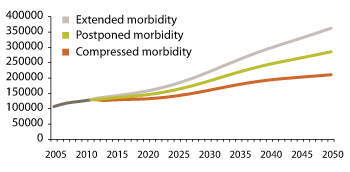
Figure 3.20 Personnel needs (2012–2050) under various assumptions about morbidity
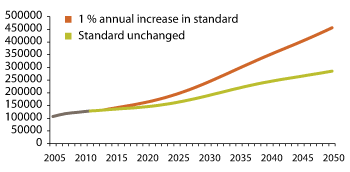
Figure 3.21 Personnel needs (2012–2050) assuming a one per cent increase in the standard of services
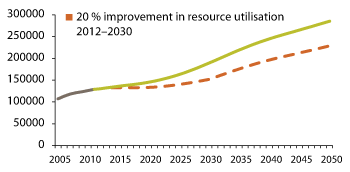
Figure 3.22 Personnel needs (2012–2050) assuming a 20 per cent improvement in resource utilisation 2014–2030 (Illustration)
Source Statistics Norway
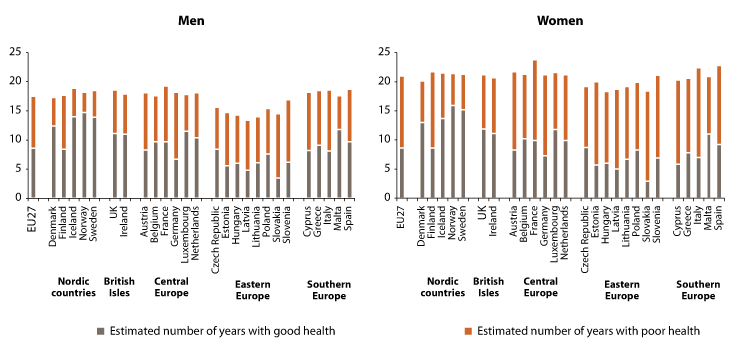
Figure 3.23 Anticipated remaining years of life and morbidity among 65-year-olds in Europe in 2011
Source http://ec.europa.eu/health/indicators/healthy_life_years/
Figure 3.23 shows the remaining years of life of 65-year-olds in selected European countries in 2011, with an estimate of the remaining years of good and poor health. The figure shows that Norway is among the European countries whose residents have the longest life expectancy and the fewest years of poor health at the end of their lives.
A review of Swedish and international research shows that various studies draw different conclusions about the development of elderly people’s health and functionality. Regardless of the differences in the methods used and the ages studied, the review of the research shows an improvement in the ability of the elderly to help themselves in daily life. By the same token, more elderly people report having specific health problems. These two development trends pull in opposite directions, and it is unclear the degree to which they balance each other out with regard to the need for care services.
The projection in figure 3.17 is based on one of many possible assumptions about the degree of postponed morbidity and an assumption that a lower mortality rate among the elderly is due to better health. This is seen in lower age-specific use of the care services, so that the amount of time with relatively serious illness and loss of functionality is about the same as before. This means that a 75-year-old in 2050 is expected to have better health and less need for care services than a 75-year-old in 2010. An assumption of postponed morbidity may be somewhat optimistic in light of the Global Burden of Disease Study 2010, but at the same time it takes into account the finding on an improvement in the ability of elderly people to take care of themselves better in daily life. For planning purposes it has been decided in general to assume postponed morbidity.
In figure 3.20 the personnel needs are projected on the basis of other assumptions about morbidity. In the case of prolonged morbidity, a longer life expectancy means that the number of years of illness and reduced functionality increases on average, and there will be more elderly people in all age groups that require intensive caregiving since more elderly are living longer. In the case of compressed morbidity, it is estimated that the number of healthy years will increase more rapidly than the higher life expectancy.
The projection does not take into account any breakthrough in dementia research, which would upset all of the projections regarding the need for care and personnel in the care services sector. About three-fourths of the residents in nursing homes have dementia as their main or sub-diagnosis. About 10 per cent of recipients of home care services receive assistance primarily because they have dementia. It must be emphasised that as of today there are no grounds to state a point in time or the potential for a breakthrough in treating various forms of dementia. All planning for the care services sector must therefore take its point of departure in the fact that dementia is a major, rapidly increasing cause of the need for care services.
Effect of changes in resource use
Several development trends point in the direction of a higher standard of services in the future. Future users of the care services will have different expectations and preferences than today’s users, and a demand to raise this standard may come from several different quarters.
Figure 3.21 illustrates the effect of a one per cent annual increase in the standard of services and shows that the demands for and expectations about more resources over time will have a major impact on personnel needs in the care services sector.
Rather than increasing the standard of services, the opportunities inherent in the demographically stable period up to 2020 should be used primarily for improving the care services related to future care challenges. More emphasis on innovation and development, an effort to bolster and reorganise professional activities and physical structures in the services, increased use of welfare technology, and better realisation of society’s care resources will improve resource utilisation and contribute to sustainable care services, also in the future. Figure 3.22 illustrates the development of personnel needs if the care services improve their resource utilisation by 20 per cent from 2014 to 2030 with improvements evenly distributed in each year of the period.
3.5.3 24-hour care needs
A major challenge in the future will be to expand the capacity of all services related to 24-hour care spaces in nursing homes and residential care homes so that Norway does not lag behind when the need for care services increasing dramatically in 10–15 years.
In 2011, 24-hour care provided by the care services consisted of some 63 000 24-hour care spaces divided among about 41 000 spaces in institutions and 22 000 residents in housing with 24-hour staffing.
The projection below shows that the need for 24-hour care spaces could grow by almost 15 000 spaces up to 2030 and 45 000 spaces up to 2050. The trend is the same as that for personnel needs. It is especially beginning in 2025 that the need for 24-hour care spaces will increase substantially.
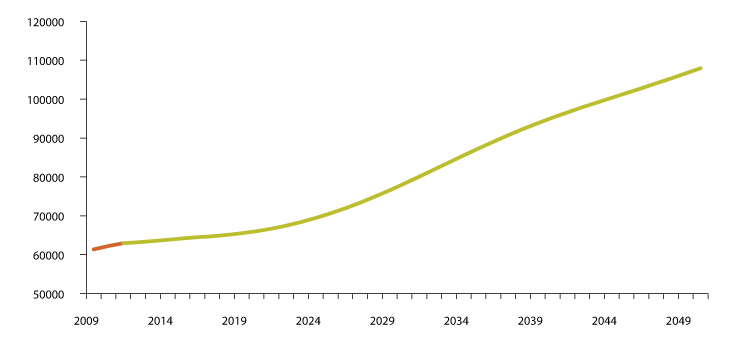
Figure 3.24 Projection of 24-hour care spaces 2012–2050
Source Statistics Norway and the Ministry of Health and Care Services
This projection is based on the assumption that tasks will be carried out in the same way with the same standard as today, that informal care will be maintained at its current level and that a longer life expectancy will postpone the period at the end of life with serious illness and reduced functionality.
Better adaptation of people’s own homes, the use of welfare technology, daytime activity programmes, an expansion of assisted living residences and greater focus on home care services and rehabilitation may be an alternative to, or help to postpone the need for, 24-hour care spaces. The average cost of a 24-hour care space in a nursing home comes to almost NOK 1 million per year. It will be an innovation task for the municipalities to test out whether using such a large sum in a different way can result in other, better solutions for individuals.
3.6 Sustainable development
The successful development of public care services to the extent and at the professional level achieved in Norway suggests that future challenges must be addressed from two angles: continuing the best of what has been developed in the past 40 years and changing the course in some crucial areas.
Public care services have undergone continual growth over several decades. In light of the demographic challenges that are expected to hit full force in 10–15 years, this growth must be organised so that it supports and triggers the resources found among the users themselves, their families, social networks and neighbourhoods, organisations and local communities. It will require a restructuring of professional activities to put more emphasis on prevention, early intervention, social networking and rehabilitation and to make greater use of new technology and work methods. At the same time, core nursing activities must be improved and medical follow-up strengthened.
The Norwegian care services model is characterised by a distribution of tasks and close cooperation between two major actors: the municipal health and care services and close family members. Future challenges raise the question of whether other actors should be given more room and more tasks and whether there should be a change in the ratio between public services, families, volunteers, the philanthropic sector, user-driven schemes, cooperative solutions, and trade and industry.
The uncertainty relating to economic trends, as seen in many countries in Europe, also suggests that the services should not be set in stone, but instead must have the necessary flexibility to address potential changes in the labour market. A focus on home care solutions and daytime activity programmes will offer the greatest flexibility with regard to family members’ work situations and the needs of the labour market. It is the group of the youngest elderly that will experience the greatest increase in the near future. Thus, demographic changes also suggest that the initial growth should be addressed with home care services, rehabilitation and preventive measures.
Overall, this will create the most sustainable situation for addressing future care challenges.